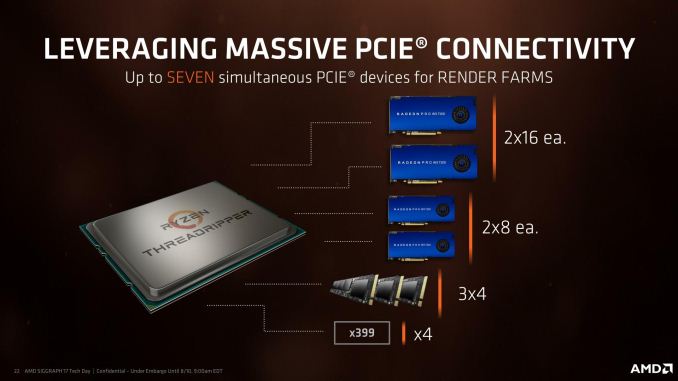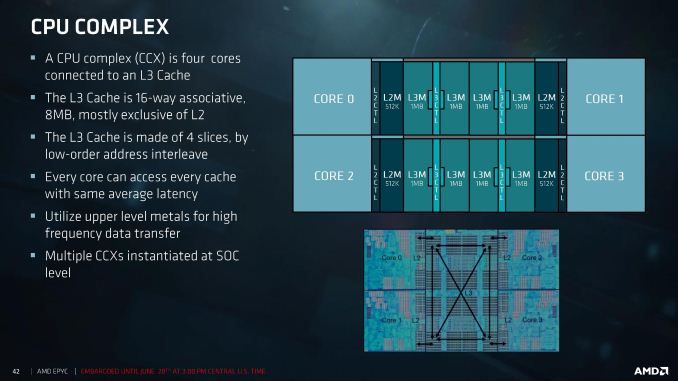The AMD Ryzen Threadripper 1950X and 1920X Review: CPUs on Steroids
by Ian Cutress on August 10, 2017 9:00 AM ESTFeeding the Beast
When frequency was all that mattered for CPUs, the main problem became efficiency, thermal performance, and yields: the higher the frequency was pushed, the more voltage needed, the further outside the peak efficiency window the CPU was, and the more power it consumed per unit work. For the CPU that was to sit at the top of the product stack as the performance halo part, it didn’t particularly matter – until the chip hit 90C+ on a regular basis.
Now with the Core Wars, the challenges are different. When there was only one core, making data available to that core through caches and DRAM was a relatively easy task. With 6, 8, 10, 12 and 16 cores, a major bottleneck suddenly becomes the ability to make sure each core has enough data to work continuously, rather than waiting at idle for data to get through. This is not an easy task: each processor now needs a fast way of communicating to each other core, and to the main memory. This is known within the industry as feeding the beast.
Top Trumps: 60 PCIe Lanes vs 44 PCIe lanes
After playing the underdog for so long, AMD has been pushing the specifications of its new processors as one of the big selling points (among others). Whereas Ryzen 7 only had 16 PCIe lanes, competing in part against CPUs from Intel that had 28/44 PCIe lanes, Threadripper will have access to 60 lanes for PCIe add-in cards. In some places this might be referred to as 64 lanes, however four of those lanes are reserved for the X399 chipset. At $799 and $999, this competes against the 44 PCIe lanes on Intel’s Core i9-7900X at $999.
The goal of having so many PCIe lanes is to support the sort of market these processors are addressing: high-performance prosumers. These are users that run multiple GPUs, multiple PCIe storage devices, need high-end networking, high-end storage, and as many other features as you can fit through PCIe. The end result is that we are likely to see motherboards earmark 32 or 48 of these lanes for PCIe slots (x16/x16, x8/x8/x8/x8, x16/x16/x16, x16/x8/x16/x8), followed by a two or three for PCIe 3.0 x4 storage via U.2 drives or M.2 drives, then faster Ethernet (5 Gbit, 10 Gbit). AMD allows each of the PCIe root complexes on the CPU, which are x16 each, to be bifurcated down to x1 as needed, for a maximum of 7 devices. The 4 PCIe lanes going to the chipset will also support several PCIe 3.0 and PCIe 2.0 lanes for SATA or USB controllers.
Intel’s strategy is different, allowing 44 lanes into x16/x16/x8 (40 lanes) or x16/x8/x16/x8 (40 lanes) or x16/x16 to x8/x8/x8x8 (32 lanes) with 4-12 lanes left over for PCIe storage or faster Ethernet controllers or Thunderbolt 3. The Skylake-X chipset then has an additional 24 PCIe lanes for SATA controllers, gigabit Ethernet controllers, SATA controllers and USB controllers.
Top Trumps: DRAM and ECC
One of Intel’s common product segmentations is that if a customer wants a high core count processor with ECC memory, they have to buy a Xeon. Typically Xeons will support a fixed memory speed depending on the number of channels populated (1 DIMM per channel at DDR4-2666, 2 DIMMs per channel at DDR4-2400), as well as ECC and RDIMM technologies. However, the consumer HEDT platforms for Broadwell-E and Skylake-X will not support these and use UDIMM Non-ECC only.
AMD is supporting ECC on their Threadripper processors, giving customers sixteen cores with ECC. However, these have to be UDIMMs only, but do support DRAM overclocking in order to boost the speed of the internal Infinity Fabric. AMD has officially stated that the Threadripper CPUs can support up to 1 TB of DRAM, although on close inspection it requires 128GB UDIMMs, which max out at 16GB currently. Intel currently lists a 128GB limit for Skylake-X, based on 16GB UDIMMs.
Both processors run quad-channel memory at DDR4-2666 (1DPC) and DDR4-2400 (2DPC).
Top Trumps: Cache
Both AMD and Intel use private L2 caches for each core, then have a victim L3 cache before leading to main memory. A victim cache is a cache that obtains data when it is evicted from the cache underneath it, and cannot pre-fetch data. But the size of those caches and how AMD/Intel has the cores interact with them is different.
AMD uses 512 KB of L2 cache per core, leading to an 8 MB of L3 victim cache per core complex of four cores. In a 16-core Threadripper, there are four core complexes, leading to a total of 32 MB of L3 cache, however each core can only access the data found in its local L3. In order to access the L3 of a different complex, this requires additional time and snooping. As a result there can be different latencies based on where the data is in other L3 caches compared to a local cache.
Intel’s Skylake-X uses 1MB of L2 cache per core, leading to a higher hit-rate in the L2, and uses 1.375MB of L3 victim cache per core. This L3 cache has associated tags and the mesh topology used to communicate between the cores means that like AMD there is still time and latency associated with snooping other caches, however the latency is somewhat homogenized by the design. Nonetheless, this is different to the Broadwell-E cache structure, that had 256 KB of L2 and 2.5 MB of L3 per core, both inclusive caches.












347 Comments
View All Comments
imaheadcase - Thursday, August 10, 2017 - link
So you lost respect for a website based on how they word titles of articles? I think you don't understand advertising at all. lolIf you want to know a website that lost respect, look at HardOCP and you know why people don't like them for obvious reasons.
Alexey291 - Thursday, August 10, 2017 - link
No offence but HardOCP is far more respectable than what we have in ATech these days.But that's not hard. AT website is pretty much a shell for the forum which is where most of the traffic is. I'm sure they only so the reviews because 'it was something we have always done'
Johan Steyn - Thursday, August 10, 2017 - link
You may not understand how wording is used to convey sentiments in a different way. That is what politicians thrive on. You could for instance say "I am sorry that you misunderstood me." It gives the impression that you are sorry, but you are not. People also ask for forgiveness like this: "If I have hurt you, please forgive me." It sounds sincer, but it is a hidden lie, not acknowledging that you have actually hurt anybody, actually saying that you do not think that you did.Well, this is a science and I cannot explain it all here. If you miss it, then it does not mean it is not there.
mikato - Monday, August 14, 2017 - link
I thought I'd just comment to say I understand what you're saying and agree. Even if a sentence gives facts, it can sound more positive one way or another way based on how it is stated. The author has to do some reflection sometimes to catch this. I believe him whenever he says he doesn't have much time, and maybe that plays into it. But articles at different sites may not have this bias effect and it can be an important component of a review article."Intel recently announced that its new 18-core chip scores 3200 on Cinebench R15. That would be an extra 6.7% performance over the Threadripper 1950X for 2x the cost."
These 2 sentences give facts, but sound favorable to Intel until just the very end. It's a subtle perception thing but it's real. The facts in the sentences, however, are massively favorable to AMD. Threadripper does only 6.7% less performance than an announced (not yet released) Intel CPU for half the cost!
Here is another version-
"Intel recently announced that its new 18-core chip scores 3200 on Cinebench R15. So Threadripper, for half the cost of Intel's as-yet unreleased chip, performs only 6.7% slower in Cinebench."
There, that one leads with Threadripper and "half the cost" in the second sentence, and sounds much different.
Johan Steyn - Thursday, August 10, 2017 - link
HardOCP and PCPer is more respected in my opinion. Wccftech is unpredictable, sometimes they shine and sometimes they are really odd.mapesdhs - Thursday, August 10, 2017 - link
I've kinda taken to GamersNexus recently, but I still always read AT and toms to compare.Ian.
fanofanand - Tuesday, August 15, 2017 - link
WCCFtech is a joke, it's nothing but rumors and trolling. If you are seriously going to put WCCFtech above Anandtech then everyone here can immediately disregard all of your comments.Drumsticks - Thursday, August 10, 2017 - link
Fantastic review In. I was curious exactly how AMD would handle the NUMA problem with Threadripper. It seems that anybody buying Threadripper for real work is going to have to continue being very aware of exactly what configuration gets them the best performance.One minor correction, at the bottom of the CPU Rendering tests page:
"Intel recently announced that its new 18-core chip scores 3200 on Cinebench R15. That would be an extra 6.7% performance over the Threadripper 1950X for 2x the cost." - this score is for the 16 core i9-7960X, not the 7980XE.
Drumsticks - Thursday, August 10, 2017 - link
Ian*. Can't wait for the edit button one day!launchcodemexico - Thursday, August 10, 2017 - link
Why did you end all the gaming review sections with something like "Switching it to Game mode would have made better numbers..."? Why didn't you run the benchmarks in Gaming mode in the first place?